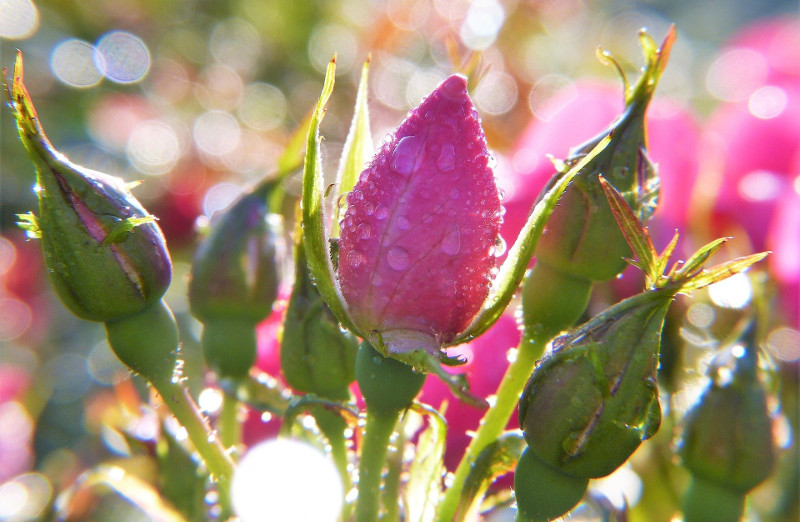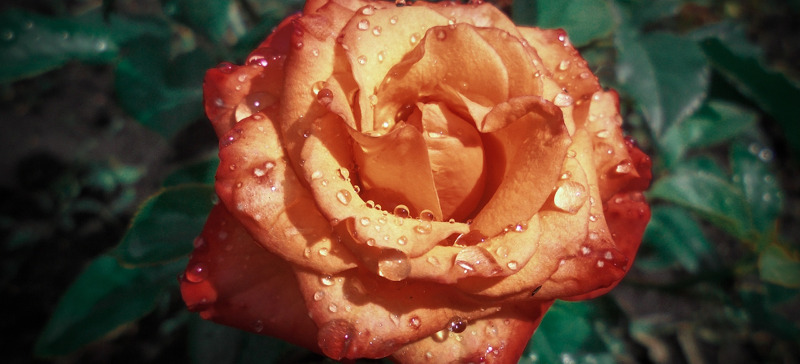Roses grow best when planted in moist soil with good drainage. Because it requires 6 hours of full sun each day, a rose also needs plenty of water to bloom and be healthy. In fact, roses love water. Watering is how the flower gets its nutrients. Water travels up the canes to deliver important nutrients for stem and flower growth and down to build a healthy root system. Deep watering equals a deep root system. Deep roots will help the rose survive drought conditions as well as winter freezes.

How much watering your rose needs will depend on many factors: temperature in your climate, soil conditions, rainfall, and windy conditions. It is best to water roses deeply ensuring that the entire root zone gets wet. Generally, that means watering to a depth of at least 18 inches deep.
How to Tell if Roses Need Watering
The first sign that your rose is in need of water is droopy looking foliage and wilting flowers. Slightly increase the watering until the plant perks back up. If you are noticing smaller or fewer blooms, your rose could be stressed from lack of water. Long term drought conditions can cause the leaves to dry up and wither and produce less blooms with the possibility of the plant dying.
Another indicator that your rose needs moisture is the soil itself. If the soil is bone dry, then water the rose immediately. If the soil feels dry to the touch 2 -3 inches deep, then it is time to water the shrub. If the soil feels damp to the touch, then halt the watering for a few days. Be careful not to overwater your rose. Too much water can starve the roots of oxygen causing root rot. The leaves of the plant become soft, turn yellow, and fall off.

How Often To Water Roses
Newly planted roses will need more watering than established roses. Because new roses have not developed a root structure, it is important that it is watered regularly. Lack of water is the primary reason newly planted flowers die. If planted in the spring or summer, new roses will need 2 gallons of water each day for the first four weeks. After that, reduce the watering to every other day.
After about 6 months, when fully established, your rose shrub will be seeking water from a wider area of soil, so you can ease off of the watering. If you have planted in the fall or winter months, evaporation is much slower and the soil will remain moist for longer periods of time. Water the new shrub once every three weeks for the winter and then once a week through spring.
From early spring through fall, most established roses will need a good slow drink of at least 2 gallons of water each week. Mature climbing roses or larger shrubs may need 4 gallons each week. In extremely hot summer months, water every three to four days.
If your rose garden is exposed to very windy conditions, the rose and the soil can dry out easily. Daily watering may be warranted. Adding a 2-3 inch layer of mulch can cool the soil down, and help to retain moisture in the soil.
Watering Container Roses
Potted roses have less soil to draw moisture from so it will need to be watered more frequently. Depending on the material of your container, the sun can heat up the pot which increases evaporation from the soil, easily drying up the rose. For these reasons, container roses may need to be watered daily with 2-4 gallons of water during the summer months. Be sure that your container has good drainage holes as roses do not like wet feet.

Best Time To Water Roses
Early morning is the optimal time to water roses. Watering early in the day allows the water to soak deeply into the soil and slowly dry up as the day goes on. In addition, morning watering allows the foliage of the rose to dry out in the sun, preventing powdery mildew or blackspot developing from wet conditions overnight.
Spring- Unless it is extremely hot in your area, watering once or twice a week is fine.
Summer- On extra hot days, keep an eye on your rose as it can get stressed easily from heat. Daily watering may be needed. Otherwise, water as needed to keep the soil around your rose shrub moist.
Fall- If the ground becomes dry, water as needed until the plant goes dormant.
Winter- During the cold season, your rose will be dormant and will require little to no water. In some cases, such as when there is no rain or snow, your rose will need a drink of water. It would not hurt to get out the hose or watering can once a month to add some moisture to the soil.
How to Water Roses
Step 1 - Give the rose less frequent, yet longer drinks.
This helps the plant to develop deep roots and gives the soil time to dry out so it does not become waterlogged.
Step 2 - Use the right watering style.
A watering can with a shower head style opening is better than one direct stream of water coming out.
If you use a garden hose, avoid high pressure watering. A slow shower like spray is better.
Step 3 - Water the soil at least 18 inches deep.
Slowly water around the base of the shrub allowing the water to soak in. It is important that the soil absorbs the water instead of the water running off the surface.
Step 4 - Always water in the morning
Avoid watering during the heat of the day as the soil will not absorb the water.
Morning watering allows the foliage to dry out before evening preventing blackspot or powdery mildew.
Step 5 - Apply a 2-3 in layer of mulch around the base of the rose shrub
Mulch will help to keep the moisture in the soil especially during hot weather.
Rose Watering Tips
- Water roses in the morning.
- Water the base of the shrub and avoid getting the leaves wet.
- Allow the water to slowly soak into the soil, 16-18 inches deep.
- Use a soft spray of water instead of one jet-like stream of water.
 |
Author Chris Link - Published 05-28-2021 |
